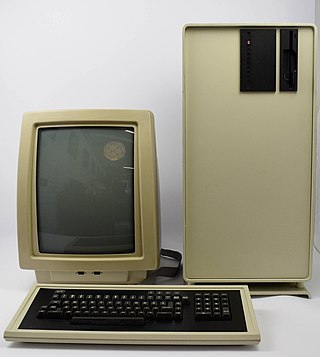Top Qs
Timeline
Chat
Perspective
Lilith (computer)
1980 custom-built workstation computer From Wikipedia, the free encyclopedia
Remove ads
The DISER Lilith is a custom built workstation computer based on the Advanced Micro Devices (AMD) 2901 bit slicing processor, created by a group led by Niklaus Wirth at ETH Zurich.[2][3] The project began in 1977, and by 1984 several hundred workstations were in use. It has a high resolution full page portrait oriented cathode-ray tube display, a mouse, a laser printer interface, and a computer networking interface. Its software is written fully in Modula-2 and includes a relational database program named Lidas.
The Lilith processor architecture is a stack machine.[2] Citing from Sven Erik Knudsen's contribution to "The Art of Simplicity": "Lilith's clock speed was around 7 MHz and enabled Lilith to execute between 1 and 2 million instructions (called M-code) per second. (...) Initially, the main memory was planned to have 65,536 16-bit words memory, but soon after its first version, it was enlarged to twice that capacity. For regular Modula-2 programs however, only the initial 65,536 words were usable for storage of variables."[4]
Remove ads
History
The development of Lilith was influenced by the Xerox Alto from the Xerox PARC (1973) where Niklaus Wirth spent a sabbatical from 1976 to 1977. Unable to bring back one of the Alto systems to Europe, Wirth decided to build a new system from scratch between 1978 and 1980, selling it under the company name DISER (Data Image Sound Processor and Emitter Receiver System).[5] In 1985, he had a second sabbatical leave to PARC, which led to the design of the Oberon System. Ceres, the follow-up to Lilith, was released in 1987.
Remove ads
Operating system
The Lilith operating system (OS), named Medos-2, was developed at ETH Zurich, by Svend Erik Knudsen with advice from Wirth. It is a single user, object-oriented operating system built from modules of Modula-2.[3][6][7]
Its design influenced the design of the OS Excelsior, developed for the Soviet Kronos workstation (see below), by the Kronos Research Group (KRG).[8]
Remove ads
Soviet variants
From 1986 into the early 1990s, Soviet Union technologists created and produced a line of printed circuit board systems, and workstations based on them, all named Kronos. The workstations were based on Lilith, and made in small numbers.[9]
Mouse
The computer mouse of the Lilith was custom-designed, and later used with the Smaky computers. It then inspired the first mice produced by Logitech.
Gallery
- The vertical screen, keyboard and mouse of the Diser Lilith
- Vertical tower central unit
- Internal view of the Lilith, showcasing the CPU boards
- Front view of the Lilith workstation
References
External links
Wikiwand - on
Seamless Wikipedia browsing. On steroids.
Remove ads





